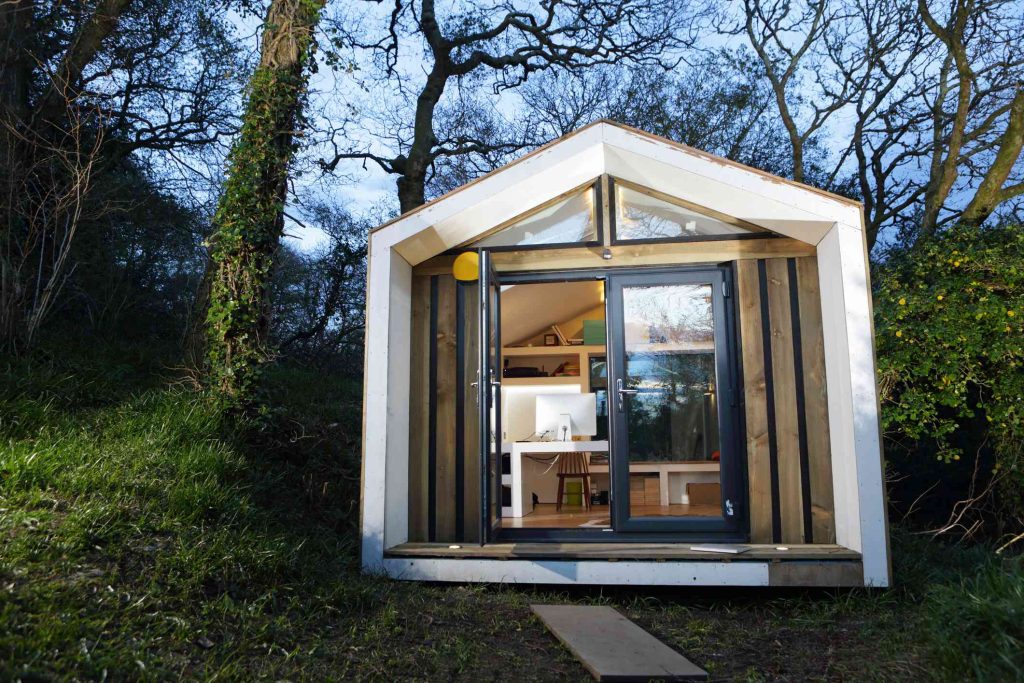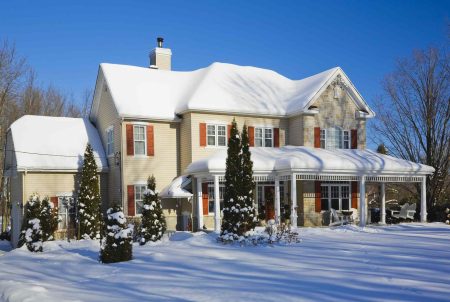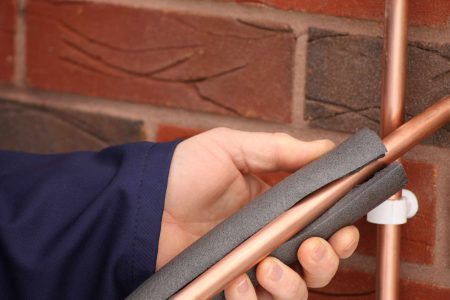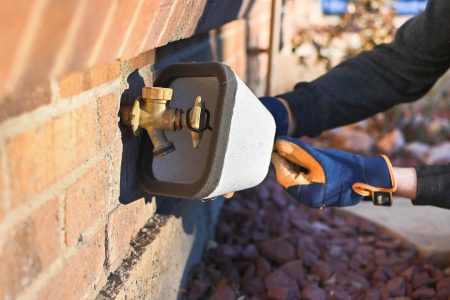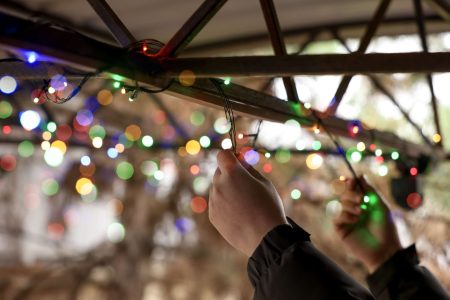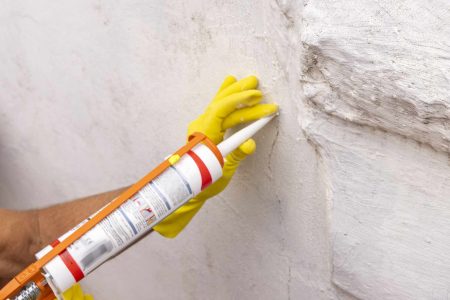Garden sheds are used for storing tools, equipment, and garden supplies, so they’re not well-suited for habitation. Sheds are not nearly as temperate as inside the home. Outside temperature fluctuations are mirrored inside the shed. It’s difficult to use a shed as an office, yoga studio, or workshop when it’s freezing or boiling. The solution is to insulate the shed.
Keeping the shed warm in the winter and cool in the summer maintains a comfortable temperature, increases energy efficiency, improves user comfort, and limits outside noise. In fact, one type of insulation, mineral wool, is remarkably good at limiting outside noise. Insulating a shed is a do-it-yourself project that’s fast to complete due to the size of the structure and its open walls. Most sheds can be insulated in a day.
Shed Insulation Materials
Insulation
Soft roll or batt insulation, either made of fiberglass or mineral wool, works best for insulating wood-framed sheds. Most wood-framed sheds are built with two-by-fours, so the appropriate mineral wool or fiberglass insulation should be 3-1/2 inches thick, or R-13 or R-15 insulation.
Fiberglass Insulation
-
Less expensive than mineral wool
-
Staples easily to the studs
-
Good R-value
-
Easy to find
-
Must be fully suited to work with fiberglass
-
Can absorb moisture
Though both are soft and fit in wall cavities, there are some differences between fiberglass and mineral wool. Fiberglass is less expensive than mineral wool, readily available, and comes with an attached paper vapor barrier. But it’s itchy to work with and it will slump over time.
Mineral wool, spun from molten basalt or slag, is about 25-percent more expensive than fiberglass and can be difficult to find. Since it is un-faced, it needs a separate vapor retarder. Mineral wool is easy to work with because it’s not itchy. Mineral wool is a better sound barrier than fiberglass insulation.
Mineral Wool Insulation
-
Not itchy
-
Non-combustible
-
Absorbs and limits sound well
-
Hydrophobic
-
More expensive than fiberglass
-
Can be difficult to find
-
Heavier than fiberglass
-
Needs a separate vapor barrier
Vapor Retarder
A vapor retarder will be required on the warm side (the interior) of the shed in cool or cold climates where the shed will be heated more than cooled. In warm climates where the shed will mostly be artificially cooled, the barrier goes on the exterior side of the insulation (between the insulation and the inner side of the shed sheathing). In mild climates, a barrier may not be needed.
With faced fiberglass insulation, the paper facing acts as a vapor retarder. With mineral wool insulation, separate 6-mil plastic sheeting is often used.
Wall Covering
While installing a wall covering over the insulation is not technically necessary for insulating a shed, it is highly recommended for optimal performance.
Mineral wool is designed to be friction-fit and stay between studs without stapling, Still, installing a hard outer covering, such as drywall or plywood, is recommended to ensure that the insulation stays in place and is protected from damage, insects, or vermin.
Similarly, fiberglass batt insulation is held in place by its paper edges, but a hard covering is still necessary to hold it in place—in fact, more so with fiberglass than mineral wool, because fiberglass has a tendency to slump.
Two-by-Four Studs (Optional)
Some sheds do not have wall studs placed every 16 or 24 inches: the customary stud width for wall systems in houses. Instead, it’s common for many ready-to-assemble to rely on the exterior sheathing for much of the structural support. This is an issue since fiberglass and mineral wool insulation are sized for 16- or 24-inch wall cavities.
Adding extra non-structural two-by-four studs holds the insulation in place. The studs also provide more places for attaching the fasteners when installing drywall or other wall coverings.
When to Insulate a Shed
You can insulate a shed at any time of the year. Installing insulation in a shed before summer or winter allows you to use the shed before the hot or cold sets in.
Mild weather, between 40 and 90°F, is generally most comfortable for working outdoors and helps you avoid the temptation to rush the project. Never install insulation in walls that have condensation. Condensation occurs when warm, humid air comes into contact with a cool surface, such as the inside of a wall.
Safety Considerations
Wear protective gear when handling fiberglass or mineral wool insulation. With fiberglass, especially, it’s critical to wear safety glasses with side shields, gloves, long sleeves, and pants. Expose as little skin as possible. Wear a NIOSH-certified disposable or reusable particulate respirator, rated N95 or higher.
What You’ll Need
Equipment / Tools
- 1 tape measure
- 1 circular saw
- 1 bread knife or insulation knife
- 1 straight edge or metal square
- 1 utility knife
- 1 staple gun
- 1 ladder
- 1 hammer
- 1 gloves, goggles, and a respirator
Materials
- 200 square feet insulation, fiberglass or mineral wool
- 2 panels rigid foam insulation, 2-inch
- 1 latex-based foamboard adhesive
- 8 panels wall covering: drywall or plywood
- 1 vapor barrier
- 1 seam tape
- 1 expanding foam insulation
- 1 caulk
- 1 door sweep
Instructions
-
Add Studs If Needed
If the walls do not have studs every 16 inches on-center, add the needed number of studs. Measure from wall to wall. Divide the distance by 16. The resulting number will tell you how many cavities the wall will need. Subtract by one to arrive at the total number of studs that the wall needs.
Cut each stud individually since wall height may vary along the length of the wall. Toenail the studs into place.
-
Measure the Shed for Insulation
Measure the walls and ceiling of the shed to determine the amount of insulation needed. If the wall studs are 16 inches on-center, count the number of full-width wall cavities (15-1/4 inches from the side of one stud to the side of the adjacent stud). Multiply the number of cavities by eight (provided that the walls are 7-1/2 to 8 feet tall). The resulting number is the length of insulation needed, in feet.
-
Prepare the Shed
Prepare the shed for insulation by removing any existing insulation or debris from the walls, ceiling, and floor. Make sure the surfaces are clean and dry. Repair any cracks or holes.
-
Cut the Insulation to Length
Sweep the floor. Unroll or unfold the insulation on the floor. Measure the height of the first wall cavity that you want to fill and then transfer that measurement to the insulation. Mark the measurement by laying the straightedge on top of the insulation. Cut the insulation with the knife.
-
Cut the Insulation Around Obstructions
Flip the insulation upside-down (with fiberglass) or leave mineral wool as-is. With the tape measure, measure the location of obstructions in the wall cavity: outlet boxes, light switch boxes, wires, or pipes. Transfer the measurement to the insulation. Cut the insulation all the way through to accommodate boxes and other items that fully penetrate the insulation. For wires, cut about halfway down the insulation.
-
Insulate the Shed Walls
Press the insulation into the wall cavities. Staple the paper facing onto the wall studs for fiberglass insulation. Friction-fit mineral wool insulation.
-
Insulate the Shed Ceiling
If the ceiling rafters are also 15-1/4 inches apart from side to side, insulate the ceiling as you did with the walls. Cut around skylights and ceiling lights.
-
Add Caulk and Spray Foam Insulation
Seal small gaps or cracks with caulk. Expanding spray can insulation is best used to insulate narrow sections above the door or window header or to fill gaps and cracks.
-
Install the Vapor Barrier
For mineral wool insulation, staple the vapor barrier across the walls. Run the barrier in a continuous strip for improved sealing. Staple to the studs. Cover the staples and any seams with seam tape.
-
Insulate the Shed Door
For basic shed door insulation, measure the dimensions of the door. Cut a piece of 2-inch rigid foam insulation to that size, minus 1-inch around the perimeter. Glue the piece to the inside of the door with foam board adhesive. Screw the door sweep to the bottom of the doors to prevent drafts.
-
Add the Wall Covering
Add the wall covering to the walls and ceiling. Drywall, wood panels, or even plywood can be used for the wall covering.
When to Call a Professional
If you are considering insulation such as spray foam that requires specialized equipment or training, it’s best to hire a professional insulation company. Replacing the shed door with an exterior pre-hung door unit is difficult, especially for a double-wide sliding or French door.
-
Can you insulate a metal shed?
A metal shed is difficult to insulate effectively. Ribbed wall panels and horizontal strengthening wall channels are obstacles to placing rigid foam insulation. Soft fiberglass or mineral wool insulation has no nailing or screwing points. Metal walls may not be strong enough to carry the added weight of insulation and wall covering. Finally, the inside of metal shed walls is prone to condensation.
-
What’s the cheapest way to insulate a shed?
Installing R-13 faced fiberglass insulation is the cheapest way to insulate a shed. Other low-cost materials sometimes used to insulate a shed, such as straw or bubble wrap, are not appropriate and should not be used.
-
Should you insulate an outdoor shed?
If you plan to use the shed as a living or working space, it probably should be insulated for all but the mildest of climates. Even if you plan to keep using a shed as storage, insulating the shed can protect paints, electronics, and machines.
Read the full article here



